[Click on BLUE links for sources and information]
When I moved to Mendocino and acquired the Sea Gull Restaurant, I had no idea what sweetbreads were. (I didn’t know how to cook at all or run a business either, but that’s a different story.) As it turns out, I wasn’t alone. Few people even today know much about sweetbreads, what they are, how they got their name or how to cook them.
According to the World Encyclopedia of Food by L. Patrick Coyle (Facts on File Inc., 1982), sweetbreads are the thymus and far less often the pancreas of a calf. In the United States, said Dr. Kathy Earnest-Koons, a staff pathologist with the New York State College of Veterinary Medicine at Cornell University, sweetbreads are almost exclusively the thymus, which is a gland in the throat and chest cavity of young animals that helps fight disease. After the animal is about six months old, the thymus disappears, which is why sweetbreads are available only in calves, lambs and kids.
I will admit I was a bit concerned about eating sweetbreads the first time I tried them. It had nothing to do with PETA. I tried vegetarianism and it simply doesn’t work for me. I have no desire to abuse animals but I also have no qualms about eating them. My reluctance was that sweetbreads seemed, well, a little disgusting after I learned what they were. My worries evaporated after I tasted them. They are delicious and not so difficult to prepare despite what many would have you believe. It turns out that sweetbreads are as American as apple pie. Even George Washington ate them. He preferred them cooked into a savory pie.
First Lady Eleanor Roosevelt was so fond of sweetbreads, Franklin D once complained he’d eaten them six times in one week.
You might think cooking sweetbreads is an impossible and daunting task for an amateur cook. That’s not true at all. Throughout this post we will use pictures from Scotland circa 1974 when I enjoyed the luxury of eating sweetbreads in Edinburgh near the famous castle inhabited by Mary, Queen of Scots.

Grave, Gardenstown, Scotland. This is where you will end up whether or not you eat sweetbreads.
”The better they are peeled, the better the sweetbreads,” said Andre Soltner of Lutece in New York. (A number of butchers sell sweetbreads frozen with the membranes already removed. Sweetbreads are highly perishable and must be used within 24 hours after butchering.) In the classic technique, the blanched sweetbreads are wrapped in towels and pressed under a heavy weight. ”Poaching them and pressing them improves the texture,” Mr. Platt said. Then they are sauteed or braised and served with a variety of sauces.
These days, however, some chefs say blanching and pressing the glands is unnecessary. ”Blanching makes them dry and mealy,” asserted David Bouley, the chef and owner of Bouley in TriBeCa. He simply soaks his sweetbreads, carefully peels them and either sautees or roasts them. [Sweetbreads: Loved but Misunderstood, Dena Kleiman]
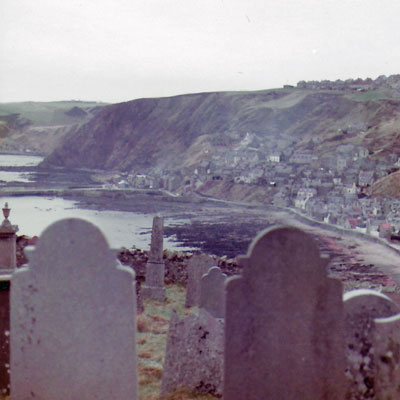
View of Gardenstown From the Graveyard
At the Sea Gull we tried to keep things simple. Our menu had a number of interesting and unusual items, but the preparation was straightforward. It’s true that peeling (removing the membranes) of the sweetbreads was not something our prep cooks enjoyed. Neither was cleaning the calamari or deboning the chicken breasts. But, these were basic tasks that could be learned quickly. And, simple preparation in no way means the results are tasteless. Sweetbreads were a popular item and remained on the menu for my entire tenure at the restaurant.
A much-quoted clue about sweetbread’s etymology comes from the 1578 work The Historie of Man. Author John Barrister writes, “A certaine Glandulous part, called Thimus, which in Calues…is most pleasaunt to be eaten. I suppose we call it the sweete bread.”
One of the best descriptions of sweetbreads and their preparation appears in the wonderful novel Everything Happens Today by Jesse Browner. [The novel is a must read and highly recommended by TITM.] At some point fairly early into the book there is a discussion between mother (bed-ridden with advanced multiple sclerosis) and the dutiful son (Holden Caulfield-like protagonist of the novel).
“Wait, Leslie.”
“Mom!”
“Wes. There is something I’d like, Wes, if you don’t mind.”
“Name it.”
“Sweetbreads.”
“What?”
“Sweetbreads.”
“You mean, like, pastry?”
“Look it up. You asked what I want. I want sweetbreads.”
“Do we have any in the house?”
“I don’t think so, honey. You may have to go to the store.”
Nearly half of the book is then taken up with learning about, procuring, and cooking sweetbreads. You might think this extended riff on gourmet cooking would be a colossal bore but it is punctuated by a series of hysterical and fascinating asides on sex, coming of age, parenting (how to and how not to), and more. If you really want to know about sweetbreads (and a lot more), read this book.
A food journalist (as much known for his work in Gastronomica and the history of hospitality in The Duchess Who Wouldn’t Sit Down as for his previous three novels), Browner brings to this novel all the details about preparing sweetbreads as a comparable talent, Nicholson Baker, brings to shoelaces, sex, kitchen matches, and just about everything else. Bruce Jacobs
Not long after arriving at the Sea Gull, my partner and I decided to visit the previous owners, Martin and Marlene Hall, who had moved near Banff, Scotland. They had purchased a farm (Cottage Farm Greenskairs) near Gardenstown and were in the process of restoring it as it had been left idle for years. We took the BritRail from London to Edinburgh. We spent one night in Edinburgh and I distinctly remember the dish I had for dinner that first and only night I spent in Edinburgh, Sweetbreads Mary Lorraine.
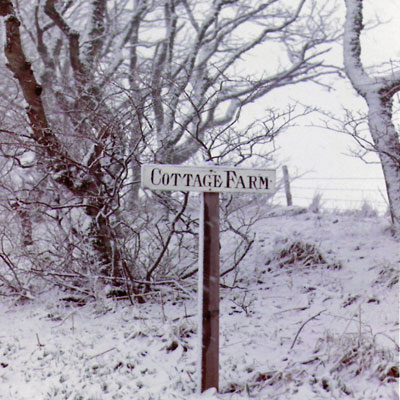
Cottage Farm Greenskairs, Martin and Marlene Hall residence in Scotland
I had become fond of sweetbreads and the name of the dish intrigued me although I was unaware at the time that Mary of Lorraine was the mother of Mary, Queen of Scots about whom a new movie has just been released. I understand there are historical inaccuracies in the movie but I’d like to see it just the same. The history of the Royals is, however you think about them, amusing and fascinating, tragic and outrageous all at once. For example:
The once refulgent reign of Queen Elizabeth had come to a stale and frustrated end in the preceding year, and a new monarch had been imported from Scotland, emerging from the rather questionable uterus of the old queen’s former rival, the amorously notorious Mary, Queen of Scots. James I was known to be very ugly and somewhat bloodthirsty (he liked hunting both witches and deer). He was also known for a very high degree of mentality and education. Among his attainments, like that of Julien Sorel in ”The Red and the Black,” was the ability to memorize the whole of the Bible in translation and to recognize any passage from its pages the moment he was shown it. Christopher Hitchens

Edinburgh Castle near where I ordered Sweetbreads Mary Lorraine
The great philosopher David Hume has in the fifth volume of his History of England about 200 pages on Mary, Queen of Scots. I am lucky to have a copy of Hume’s history via my friend JP. A short summary of one of the controversial issues surrounding the Queen (the Marian controversy) that concerns Hume’s history can be found HERE.
It seemed appropriate to order sweetbreads while in the British Isles. Charles Dickens occasionally wrote of them in his novels. Although I did not know it then, I was in good company as they were a favorite of Catherine de’ Medici, the mother-in-law of Mary, Queen of Scots. “Catherine de’ Medici herself was renowned for her greed and is said to have almost died from overeating béatilles (tidbits) a glorious concoction of sweetbreads, kidneys, cocks’ combs, and artichoke hearts.” [According to The Cookbook Library: Four Centuries of the Cooks, Writers, and Recipes That Made the Modern Cookbook (see Eating Like A Queen) By Anne Willan and Mark Cherniavsky]
An Aside
On the bus from Edinburgh to Banff I photographed a young girl who told me her name was Emma of White Rushes. I’ve often wondered what happened to her. She must be about fifty by now. I’ve often thought about writing a fictional story of her life (young man visits Scotland, is charmed by female child, years later leaves her his fortune, and this ruins her life–something like that). It’s one more of those things I must get around to some day.

Emma of White Rushes
The two major events that I remember from that time were the Oil Embargo and the comet Kohoutek which was first sighted on March 7, 1973 and attained perihelion on December 28. On the night of our arrival we went outdoors to see the comet. Aware of the oil crisis, I made sure to close the door behind me to save energy. Little did I know that the door was locked and that no one had thought to take the key. It was snowing heavily by then and neither the sky nor the comet was visible. I had to jimmy the cellar window and squeeze inside so that I could let everyone else back in through the front door.
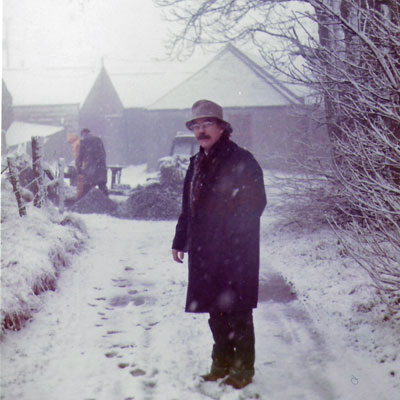
Martin Hall, Cottage Farm Greenskairs
Sweetbreads are strictly supporting players in Hollywood, recently as Sweetbreads à la Gusteau with white fungus and a chili-licorice sauce in Ratatouille. And in 2002’s Red Dragon, the fussily carnivorous Hannibal Lector serves a sweetbread ragout to dinner guests—human sweetbreads, of course.
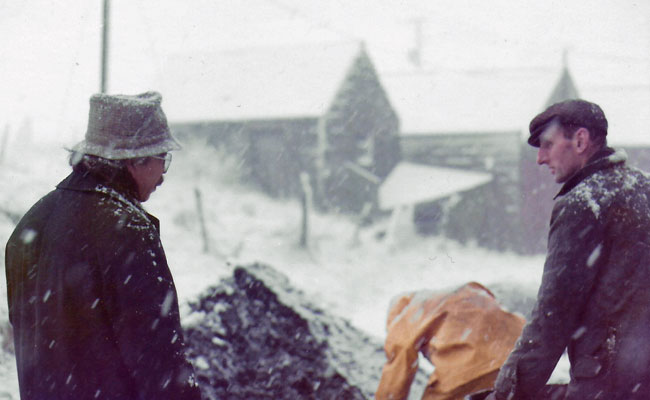
Martin Hall, coal delivery
A few months ago I read that sweetbreads are making a comeback. I do hope so as they are delicious.

Gardenstown
And now, this is how we cooked the sweetbreads at the Sea Gull, so simple and straightforward as to be almost unbelievable. But, it’s true, and THEY WERE DELICIOUS.
Sweetbreads Recipe
Soak the sweetbreads (veal) in water. Drain and remove as much of the membrane as possible while separating the sweetbreads into bite-size or slightly larger pieces. Dry. Dip in whisked egg solution and roll in fresh cracker crumbs. Brown the breaded sweetbreads in an electric skillet [we used an electric skillet for many entrees, not the grill nor the sauce pans) with butter and olive oil. Finish by adding sautéed mushrooms. Serve with vegetables of the night and baked potato.
THAT’S IT !

Gardenstown, Scotland, circa 1974

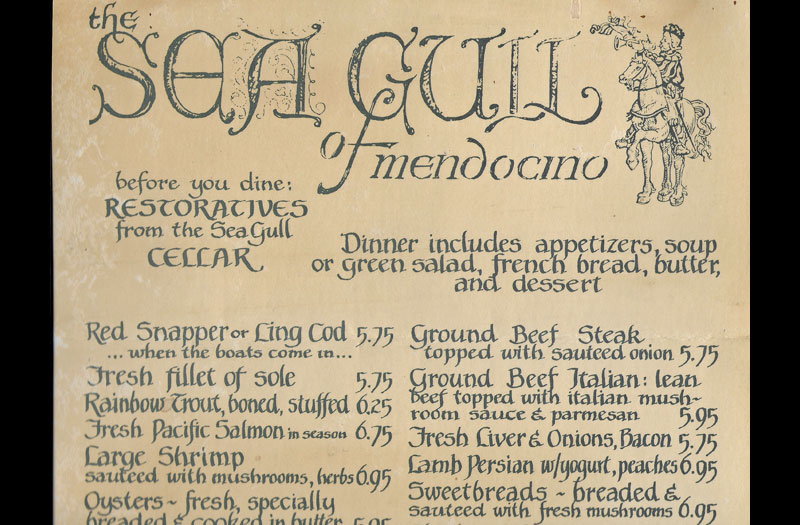
Wow! Inflation. Thought the Fed and Feds tell us there is none?
David, you should Anthony B.’s place on CNN.
Nice post though “not in my kitchen.”
My favorite treat at the Sea Gull! Thanx for demystifying. I wonder if any grocery carries them locally??
Probably by special order. I checked with MENDOSA’s in Mendocino and they do not have them.
Great reading and pictures of Scotland.
Thank you,
Rhoda